On The Trail Of Genghis Khan
An Interview With Tim Cope
Andrew Mazibrada
In Sidetracked Volume Four, we featured a story about Tim Cope’s three year journey, on horseback, from Mongolia to Hungary, on the trail of Genghis Khan. His book based on the journey, On the Trail of Genghis Khan: An Epic Journey Through the Land of the Nomads (Bloomsbury) was awarded the Grand Prize in the 2013 Banff International Book Competition. Andrew Mazibrada caught up with Tim before he left for Mongolia again to learn more about his incredible journey.
Andrew: Where did your love of Russia, Mongolia and Central Asia come from?
Tim: In 1998 I abandoned a Law degree in Australia to study to be a wilderness guide in Finland. The twelve-month course focused on traditional Finnish culture in the boreal forest zone and tundra of the Sub Arctic. The year entailed, among other things, three expeditions (by canoe, foot and ski) into nearby Russia. They were journeys that opened my eyes to a world that had been more myth than reality for someone like myself who had grown up in rural Australia. Russia at that time was going through a chaotic period of transition – in 1998 there was an economic meltdown. Many people had not received salaries in six months or more, and some people I met were living off fishing, hunting, and the gathering of forest food to survive. One of our journeys involved hiring a Soviet era helicopter (which, in 1998, was outrageously cheap), packing it with 10 canoes and equipment for three weeks, and having the pilot drop all sixteen of us students in the wilderness to paddle back to civilisation.
During these first journeys to Russia, I was struck by the people who, whether they were families subsisting in remote, mostly abandoned villages, or in larger centres, showed an open-door culture of hospitality and a remarkable sense of spontaneity and celebration. The people of Russia were as diverse as the landscapes, and all attempting to reclaim their unique identities in the wake of the Soviet collapse. Over time I became intrigued by the connections between people stretching across this vast land based on a common environment and way of life. The mysterious eastern origins of the Finns inspired me too. I was beguiled by the thought that there were interrelated cultures and languages, and entire histories yet unknown to me that transcended modern state boundaries.
I began studying Russian before the year was out, and when I graduated I forfeited my ticket home to Australia. A friend, Chris Hatherly and I plotted to explore Russia and Siberia by bicycle. In September 1999, with a budget of just $2 a day, we set off from north of St Petersburg, aiming for Beijing. In the 14 months ahead, we experienced frostbitten toes, the woes of northern Russia’s snowmelt, and even found ourselves pushing the bikes along the BAM railway in Siberia to the north of Lake Baikal. Yet this adventure was a way into the heart and soul of the people – many of whom adopted us like long lost relatives. In the end, we would traverse Mongolia where I would become inspired by the nomadic cultures of the steppe zone. Seeds of future journeys were planted there.
You speak fluent Russian and you guide in Siberia and Mongolia. How did you come to learn the language, and learn enough of such a dangerous area to guide in it?
I’ve been learning Russian since 1998 when I studied with Russian students in Finland and made my first journeys to Russia. Over the decade that followed I spent the majority of my formative years in Russia, Ukraine, Mongolia and Central Asia more broadly, where it is crucial to know the Russian language. Apart from my 14 month bicycle adventure from north-west Russia to Beijing, I also undertook a 4,500km rowboat journey down the Yenisey River in Siberia to the Arctic Ocean, and later a three year journey by horse from Mongolia to the Danube River. These fuelled my passion for traditional cultures, drove my writing and film projects, and inspired me to take people to Mongolia and Siberia to experience life there first hand. I’ve been taking groups to the Altai in Mongolia, including two school groups, every year since 2008.
I don’t see Mongolia, Kazakhstan, Russia, and even remote Siberia as being dangerous places. When I was in Finland and studying traditional ways in which Finns lived in the forest, I learnt that what appears to be hostile wilderness to one person, is another person’s garden from which everything required to sustain life can be found. I take the same approach to people and society at large – by learning about the history, language and culture, one can learn how to see the world through different eyes, and therefore not only gain deep, horizon-extending understanding, but reduce risks. If I return to University one day I would love to study anthropology – what fascinates me most is the way in which cultures have evolved, hand-in-glove, with their environments.
What sort of relationship do you have with local people in Siberia and Mongolia? How important is it to have a strong relationship with local people when guiding?
When my horses were stolen on just the fifth night of a journey from Mongolia to Hungary, it felt like I had lost almost before I had begun. However I was fortunate to find the horses the next day. A nomad returned them to me, saying: ‘A man on the steppe without friends is as narrow as a finger… a man on the steppe with friends is as wide as the steppe.’ I needed to leave my baggage behind as a westerner, reach out of my dream world, and get to know people, however unfamiliar. Over the course of the next year, I came to realise just how fundamental that saying would be, not only for my survival (and that of my animals), but also for truly getting into the fabric of a place and understanding the people. It doesn’t matter whether it’s guiding, journeying, or just visiting a place – in my opinion it’s coming to know the people on their terms that is the most important aspect of travel. I have friends right across Central Asia, Mongolia and Siberia, and my friendship with them is the true measure of my travel.
‘A man on the steppe without friends is as narrow as a finger…
a man on the steppe with friends is as wide as the steppe.’
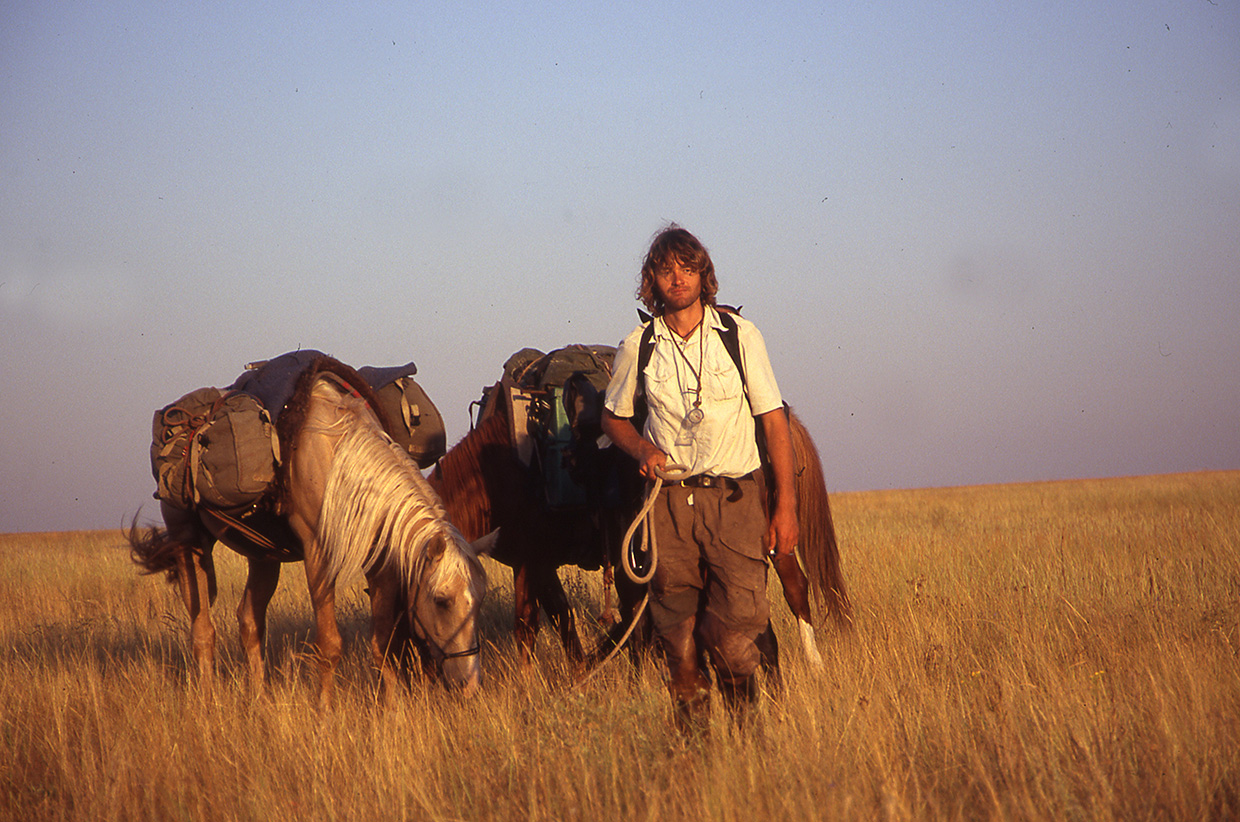
Tell us more about the Trail of Genghis Khan. First of all, what drew you to that epic trek?
The journey was in honour of the untold thousands of nomads who have made the great trek from one side of the steppe in far east Asia, to the western tip in Europe on the Danube River. Horseback societies have been traveling through these plains, deserts, and mountains ever since the horse was first domesticated about 5,500 years ago. The most famous of all were the Mongols, who under Genghis Khan set out in the 13th century and formed the largest land empire that has ever been.
With that in mind, the trigger for my journey was in September 2000, when I found myself in Mongolia on a bicycle en-route to Beijing. At that stage my friend Chris and I were 12 months into our recumbent bike trip, and I had fallen in love with Russia… but nothing could have prepared us for Mongolia. While pushing our heavily-laden bikes through miserable sand tracks in the Gobi desert, these nomadic people would just appear with great ease from over the horizon, then set off in whichever direction they pleased. It dawned on me that these people live in a world without fences, without private property, and a climate that ranges from -50 and colder in the winter, and 50 degrees of heat in the summer. They have little more than a few inches of tent felt to insulate them from those extremes. I felt like little more than a wimpy tourist pushing my bike along a predetermined path.
Over time I learnt more about the Mongols, and the heritage of the Eurasian steppe, and realised that, despite arbitrary national borders, the steppe still carries on unbroken to the west as far as the danube, unfenced, and with nomadic and formerly nomadic societies all connected by a horseback heritage. It was really very logical: to understand what life was like on the steppe, and what had happened to all the nomad societies in Soviet times, I would have to get on a horse and ride it to the Danube! Four years later I returned to Mongolia with exactly that plan.
What research did you do – not only about the region you would be travelling in, but also into the history of Khan himself, and his people?
Researching the history of the Mongols (and the many other nomadic groups that have been traversing Eurasia since the horse was first domesticated) was every bit as crucial as anticipating the logistical challenges.
The journey was based around the idea of riding from east to west with a troupe of horses (and the occasional camel), arriving in Europe to look back at the sedentary world through a nomad’s eyes. Genghis Khan inspired me simply because I think for most of us, we struggle with the concept that the ruler of the largest contiguous land empire in history was not a king in a castle sitting on his throne, but a nomad who was illiterate, and spent the duration of his life on horseback and in a tent. In our world, we tend to underestimate and misconceive the very concept of nomadic life and culture as something somehow backward and primitive. The history of the Mongols turns these assumptions on their head. The only way to come to know nomad culture I realised was to ride a horse myself.
To me an expedition is like field research. Writing has always been joined at the hip with adventure for me, so I set off with a concept, some questions, and came back after three and a half years with some answers but even more questions. To write the book I spent three years writing and researching that first draft, then another year rewriting.
The preparation time for my journey was about 18 months, which mostly involved coming up with the themes of my journey and researching them, figuring out the complex logistics of traveling with animals (in the end I would need to cross borders with three horses and my Kazakh dog Tigon), learning about horse equipment and getting the right kit, and of course raising the money. It’s true that I could have put more planning time in, but I came to the conclusion that with any project or adventure, it is important to put a limit on preparation time. Ultimately I could have planned for 40 years for this journey and never have been ready. It was all about embracing the challenges, and trusting that the unexpected challenges would equip me with the knowledge and skill to overcome the known obstacles that lay ahead.
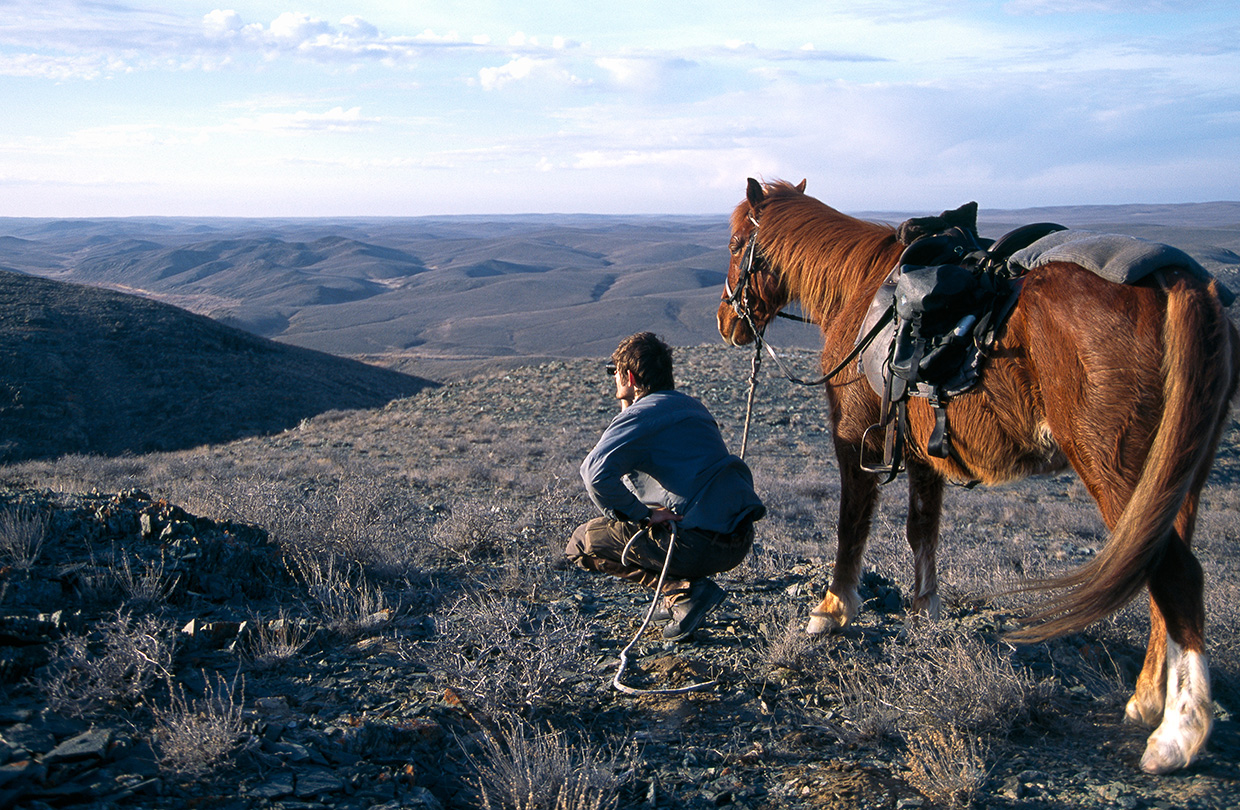

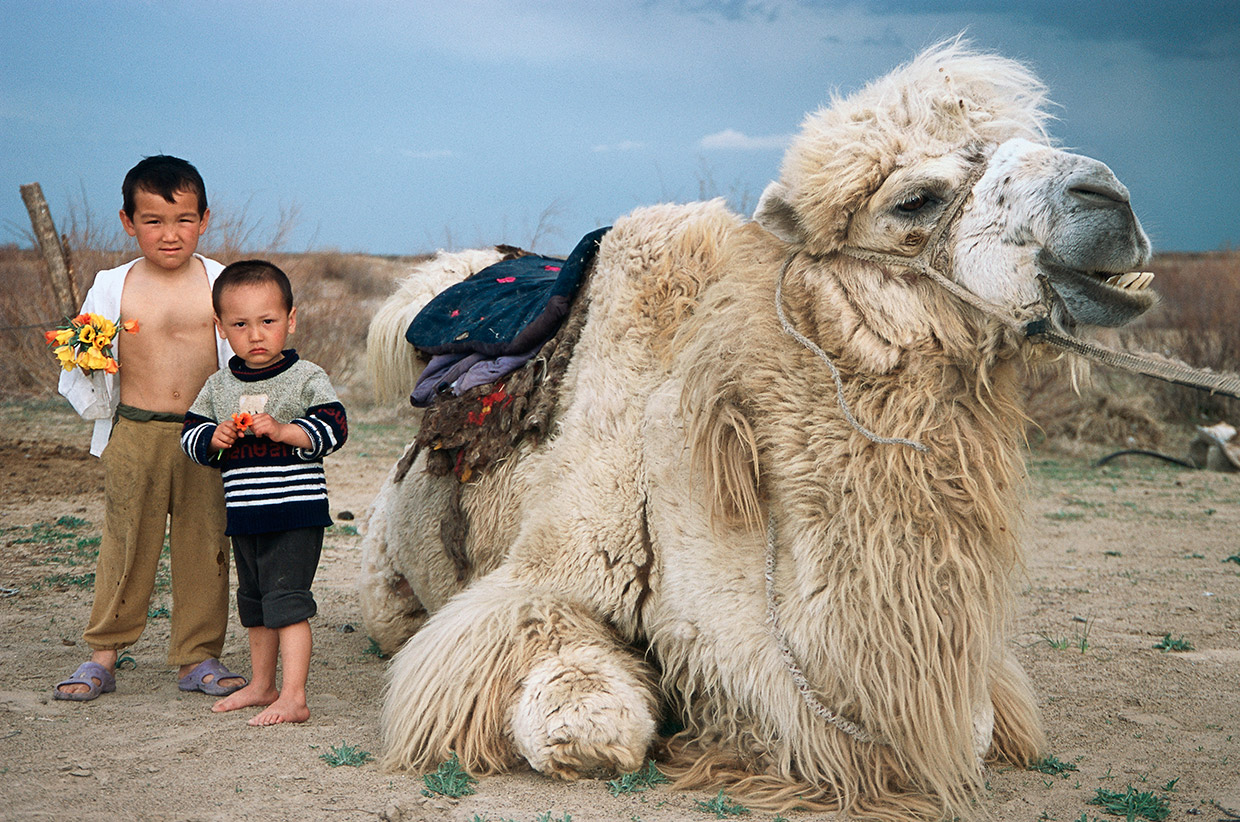
And what sort of challenges did you face on the Trail?
The dangers and challenges on this journey were varied. As a novice horseman, the horses themselves presented some serious risks – one the things I was scared most of initially, was falling off and injuring myself and having the horses abandon me in the wilds of the steppe (especially in the depths of winter). This never transpired, but in the course of my journey looking after the horses in all manner of conditions proved to be one of the greatest difficulties. Horse rustling was a major issue as I’ve already mentioned – as they say in Russian, the most dangerous wolf is that which walks on two legs.
Although the blizzards, and -40 degree temperatures, during my first winter were difficult, the most challenging environmental conditions for both the horses and I were in the Kazakh desert during the summer, when the temperature regularly reached well over 40 degrees. The only way to survive the heat was to ride all night, and seek shelter with nomads during the heat of the day. The day-to-day challenge of finding water and grass during this time became extreme, and in a state of increasing lethargy, there were many close calls, including one situation when a horse very nearly drowned in a swamp after it dived in to reach a patch of greenery. It was a reminder of just why the Mongols always mounted their conquests in the autumn and winter months, when the horses can eat the snow to hydrate, when it is possible to cross frozen rivers, and when there is no risk of the horses overheating.
Wolves were also a threat – in Mongolia my campsite was surrounded one night by wolves and in the winter I was constantly warned that wolves roamed in packs and would stalk my animals. As a precaution against this, I decided to carry firecrackers which I would light and throw out of the tent at night before going to sleep. I was told that this would help deter them from coming in close to the camp at night.
Isolation was a challenge too. It was the first journey I had ever carried out alone, and as it became clear that my journey would take much longer than the initial plan of making it to Hungary in 18 months, the feeling of aloneness became acute. I learnt the real value of friends and family. It took more than three years to eventually reach Hungary, by which time I was more than aware of the meaning of the Kazakh saying: ‘mountains never meet, but people do.’
I can’t leave this question without mentioning my adventure in Akbakai: a bankrupt gold mining village in central Kazakhstan where I became stuck for more than 3 months in the winter. Initially I stayed with two Russian alcoholics who caught street pigeons for Christmas dinner and gave me an introduction to the realities of the town, where most people relied on the murky world of contraband gold mining and trading for survival, and the less fortunate survived by catching pet and stray dogs to survive… it’s all in the book.
Did you have to learn skills you didn’t already have?
It is hard to overstate how much I needed to learn during this journey. When I first arrived in Mongolia, my experience on horseback totalled little more half an hour as a boy (when I was bucked off and broke my arm), and then a five day packhorse journey with a tour group here in Australia. It’s true that I did a lot of research on equipment, and how best to travel with horses, but nonetheless I can’t say I knew much about horses when I began.
The whole point of the journey was to ride the tough steppe horses that once carried Mongols into Europe and beyond. The descendants of those original wild horses, the steppe horses, have to forage for themselves all year round. These horses are the only kind that can tolerate the extremes of weather on the steppe – a thoroughbred for example wouldn’t last two days on the Mongolian steppe in winter. Proof of this happened in the 13th century when friar Giovanni di Plano Carpini, en route to Mongolia, was told in Kiev that he would have leave his European horses behind because “Tartars have neither hay, nor straw, nor fodder, and they would all die.”
Much more than that, though, it was by travelling with the steppe horses that I would be able to transcend the modern industrialised era, and sink into the distant past, free from the shackles of roads. After all, the needs of a horse (grass and water) have never changed, and I was counting on the horse to help immerse me in the mindset of the nomad.
You can probably gauge from this that I needed to learn not only to become a horseman but everything that entailed – learning to read the landscape for water and pasture and threats like wolves and thieves. Figuring out how to keep us all healthy and moving in extreme conditions. I needed to learn nomadic culture too, not just the landscape, and from the inside out. The horses became my conduit for both.
There is a list as long as the steppe I could write about the new skills I learned – another was coming to terms with a treeless landscape that does not offer fuel for heating or cooking. I understood the fragile balance between life and death on the steppe, and how too many animals can turn the grasslands to desert within a few years, but how too few means catastrophe – among other things they won’t provide enough manure (used for fuel) to keep a family alive through the winter. The most important were the steppe wisdoms, like the one I was told in the post-apocalyptic mining town of Akbakai in central Kazakhstan. Rushing is sin – ‘if you have to rush in life… rush slowly.’ It became my mantra and helped me overcome many problems as the journey ballooned from 18 months to three-and-a-half years.
I travelled together with a nomad man called Dashnyam, and the combination of glaciated peaks and rolling alpine pastures, punctuated by the white flecks of nomad tents, made it a magical experience.
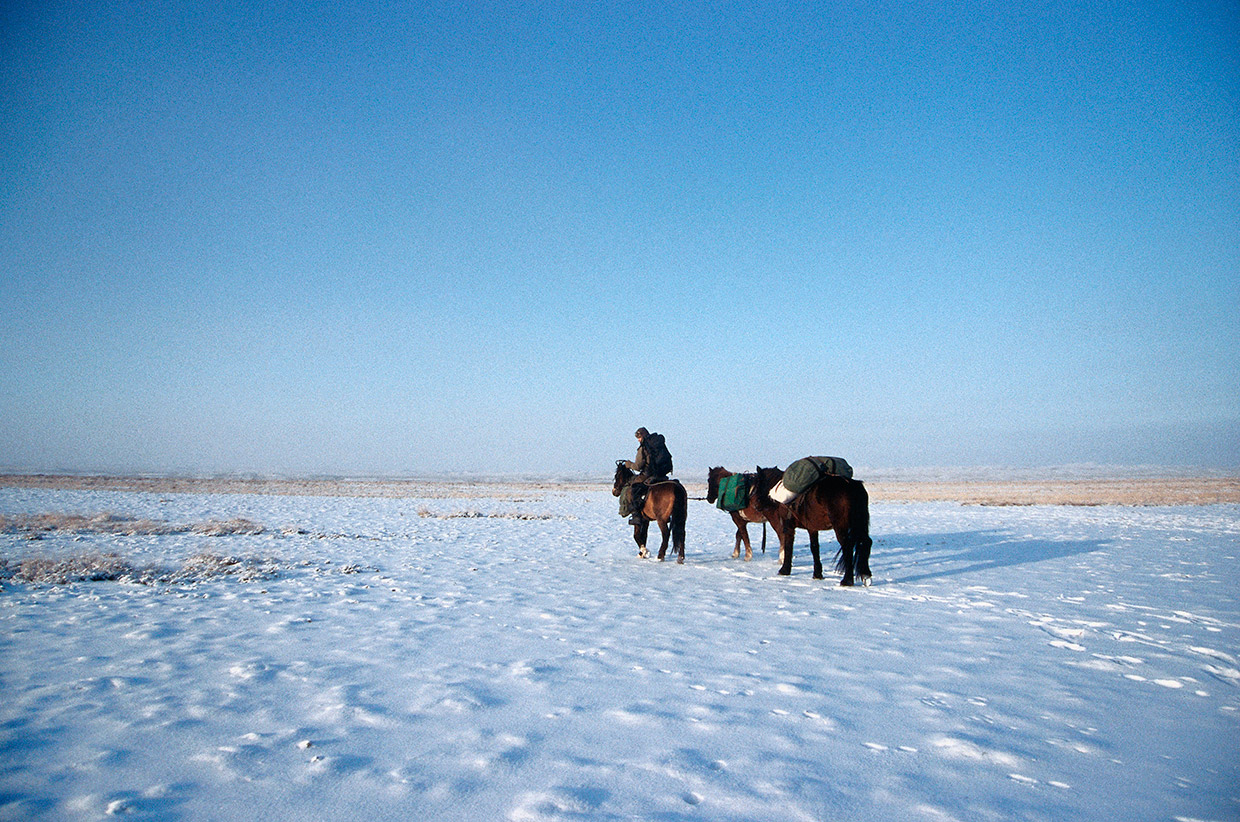
There are obviously so many memorable moments from this journey. Could you describe a couple of those for us?
My favourite experience, if I had to choose, was crossing the passes of the 4,000m peaks of Kharkhiraa-Turgen in Western Mongolia. Here, I encountered a place where nomads still moved with their camel trains from pasture to pasture, in a part of the world where mechanisation is virtually absent. I travelled together with a nomad man called Dashnyam, and the combination of glaciated peaks and rolling alpine pastures, punctuated by the white flecks of nomad tents, made it a magical experience. I have since returned to that part of the world many times, including this year, and although Ulaanbaatar (the Mongolian capital) has recently changed dramatically with the influx of mining wealth, life in the outer reaches of western Mongolia is largely untouched.
The hardest moment was the least expected. Having traveled for two-and-a-half years and with the toughest terrain and majority of distance behind me, I was in Southern Ukraine heading into winter when, via satellite phone, I discovered that my father, Andrew Cope, had just been killed in a tragic car accident. I left my horses for Australia immediately. Dad’s influence had been a huge factor in my decision to pursue a life of travel and adventure.
The irony for me at that stage could not have starker – here I was living an adventure that had so many inherent risks that many would consider it ‘dangerous’, yet my father had been killed just 50km from home in a car! To deal with his his death I drew on much of what I had learnt from the nomads about the transience of life.
In the end, I spent more than 4 months in Australia, grieving with my family – I am the oldest of four children. After this I made the difficult decision to return to Ukraine, and continue with my journey. Acutely aware of the fragility of human life, those last 1,000km to the end were some of the most emotionally difficult of any chapter of the greater journey from Mongolia.
What were the highlights of travelling with an animal as a companion on such a long journey alone? And what were the struggles?
The horses gave me insight, and a bridge if you like, to the land and the culture that can’t be substituted in any other way. Horses have finely tuned senses, and see and hear things coming long before we humans do. They helped me tune into the steppe, its moods, its inhabitants, the dangers, the good grass, where the water was, and so on. They are not to be seen as a mode of transport, rather as companions who are on the frontline. Through them I was tied to the land, and was locked out of cities (there are not many hotels these days that offer stables!). The horses, and my dog Tigon, also offered an unbroken connection to the ancient past and, in places like Kazakhstan, Russia and Ukraine, helped bring nomad traditions to life as I passed through.
It is, on the flip side, by far the hardest form of travel I have ever encountered. The easiest day on the horses was still tougher than the hardest of my bicycle and rowboat journeys, and I don’t say that lightly. On a horse the job doesn’t end when you climb out of the saddle for camp – this is where the real work actually starts. Apart from the general challenges of keeping the horses from dropping underweight, steering them through blizzards and heat, finding water and grass, avoiding thieves and trucks and wolves, border permits become infinitely more difficult with horses. I spent a total of six months languishing on borders with my caravan of animals, often unsure until the last minute as to whether I would be allowed to cross. It is also true that on a horse you lose the independence of other forms of travel – you are bound by where the good water and grass is, and when the horses are tired you cannot go on, even if it means hanging around in a dodgy part of the world.
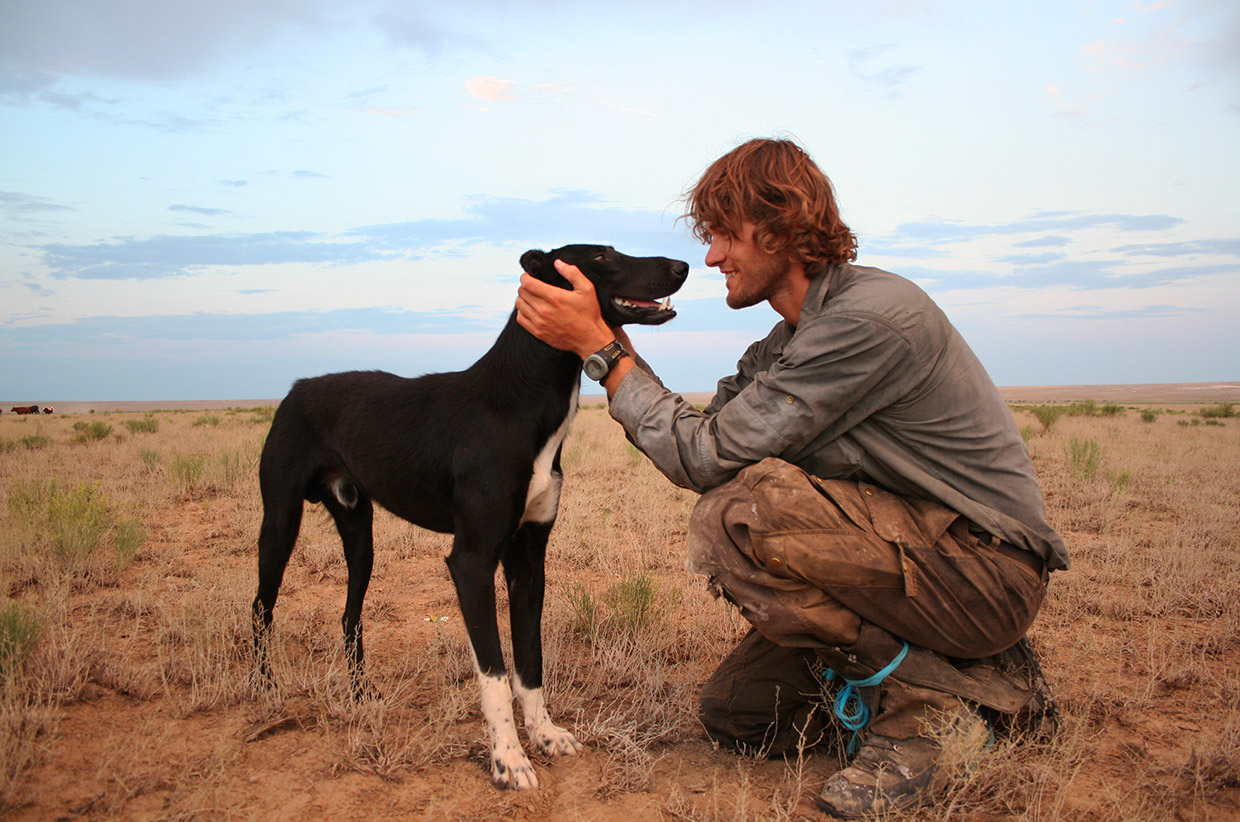
During the early stages of your trip you inherited Tigon a half-Kazahk Tazi and half-Shepherd dog from a local herder. Tell us about Tigon and how he influenced your journey.
On the steppe they say that dogs choose their owners and that is certainly how my relationship began with Tigon. Aset, with whom I travelled for 10 days, recognised Tigon’s interest in me, and before he left me, he said, ‘you need someone on this long road to protect you from wolves, keep you warm at night, and be your friend.’ That is when he gave me Tigon – a six month old pup, all skin and bones, a breed called ‘tazi’, which is a sight hound related to the Middle Eastern Saluki. I didn’t think that Tigon would survive more than a few weeks through the winter when the coldest temperature was -52 degrees. In fact he used to leap up onto my shoulders to get his paws out of the cold and sleep in my down jacket at night. But within just a few days of having Tigon I knew it was meant to be – I called home to Australia to discover our family dog of 15 years had died the same day.
Yet Tigon’s journeys ran parallel to my own, and he grew up on the road as I did. One of his most challenging moments came in Akbakai in the winter of 2004, when unemployed mine workers stole him to eat. Fortunately seven days later, moments before he found the dinner plate, he was rescued from his prison where he had been starved and beaten, and was caked in greasy muck. It took three weeks for him to recover enough strength to go on, and although I wasn’t there when he was found, I was told that for the first 24 hours after being rescued he was put in a sauna, and fed raw eggs and vodka.
Tigon appealed to the better side of people no matter who they were and I believe this was his secret for getting through to the Danube alive. Along the way he was hit by a car and almost killed, stolen at least twice more, and turned back by border guards. As he grew into a man, he learnt to fend for himself against packs of giant mastiff dogs, became a father, and burrowed his way into the hearts of those he met. By the time we were in Ukraine, Tigon had become much more than the passenger, and was so spoilt by local people that he would no longer accept bread from strangers unless it was first lathered with cream and jam!
For Tigon, travel, and the freedom of movement, the new horizons that every day brought were paradise, and as we went through all manner of trials and tribulations his mood swung in sync with mine.
What’s next for Tim Cope?
The last seven years have been focused around making a three-hour film series about my journey, and a book. My next project is a children’s picture storybook about my journey through the eyes of my dog Tigon, and a young adult version of the current book. Beyond that I have a few ideas that I’ve been working on, such as the gypsy trail from India to Europe, a year living, with nomads, Tibet and Kashmir, but I will cross those bridges when I reach them.
On the Trail of Genghis Khan has become an Australian bestseller, and in 2013 was the recipient of the Grand Prize at the Banff International Mountain Film and Book Festival, and also took out the award for best adventure travel title. In 2014 the book was shortlisted for the non fiction category of the Australian Book Industry Awards (ABIA awards).
Website: timcopejourneys.com
Facebook: /timcopejourneys
Twitter: @TimCopeJourneys
All photography © Tim Cope. Tim’s story ‘Wolf Totem’ is featured in Sidetracked Volume 04




